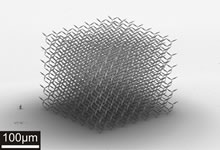First-ever pentamode metamaterial for acoustic cloaks
02 Jun 2012
 Researchers at the Karlsruhe Institute of Technology in Germany have created a prototype of a pentamode metamaterial, a class of materials with unique properties that allows them to control and steer mechanical waves.
Researchers at the Karlsruhe Institute of Technology in Germany have created a prototype of a pentamode metamaterial, a class of materials with unique properties that allows them to control and steer mechanical waves.
The materials were proposed theoretically in 1995 but haven't been realized practically until now.
The new material could be used to design new types of loudspeakers and more efficient microphones. It could also lead to acoustic cloaks that would make an object invisible to sound by directing sound waves around it.
Such cloaks would be useful for rendering ships or submarines impervious to sonar, and for noise-proofing spaces. The researchers, led by Martin Wegener, published their results online in the journal Applied Physics Letters.
Metamaterials are artificial materials with carefully engineered structures that lead to properties not found in nature. They have found applications that rely on the material's periodic structures affecting the flow of electromagnetic waves.
Researchers have used them to make superlenses that achieve resolution beyond the diffraction limit faced by conventional lenses; antennas that radiate more power; and cloaks that make objects invisible.
Wegener's work is part of recent efforts to make metamaterials that can manipulate mechanical waves in a desired manner. Such substances could steer acoustic waves in a certain direction or guide stress out to the sides of a structure so that it doesn't buckle.
The issue with making such materials for mechanics, unlike for optics, is that you have to deal with different types of waves, such as pressure waves and deforming shear waves, Wegener says.
He adds, ''The problem is that the wave enters the material as a pressure wave, but then you get pressure and shear waves, and you can't [control] the shear wave.''
One solution to that problem is a pentamode material, which a mathematician duo at the University of Utah proposed in 1995. The idea is to make a material with a very small shear modulus, which relates to deformation, but a large bulk modulus, which measures resistance to uniform compression. The material would thus be easy to tilt sideways but not easy to compress, similar to fluids or gases.
In fact, the structure proposed by the Utah mathematicians is composed mostly of air. It looks like a scaffold of precisely arranged needles that only touch at one point on their tips.
''To make a stable structure that you can hold in your hand you need to make the point-like connection finite,'' Wegener says. That's exactly what the researchers did.
They manufactured the metamaterial using dip-in laser writing, a novel technique they have developed to create nanostructures. The researchers place polymer photoresist on a microscope's objective lens.
Then, a computer program scans a tightly focused femtosecond laser pulse in three dimensions across the resist. This allows the researchers to create any arbitrary structure they design on the computer. The exposed photoresist hardens into the shape they want-in this case, the needle-like structures of a pentamode metamaterial-and the rest of the resist is washed away.
The ideal ratio of bulk modulus to shear modulus in a pentamode metamaterial is infinite. The German researchers obtain a ratio of 1000. ''It's spectacular what they've done,'' says Graeme Milton, one of the Utah mathematicians behind the idea of these materials. ''The pentamode material is an ideal, and they get really close to the ideal.''






















